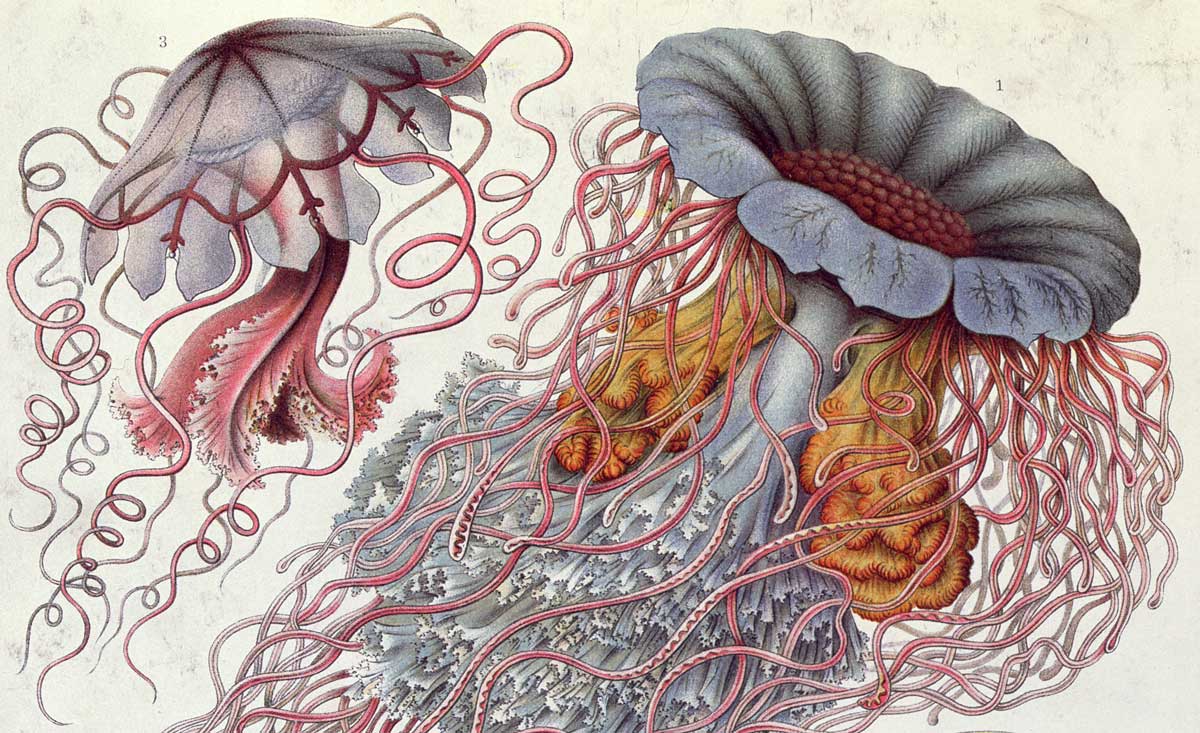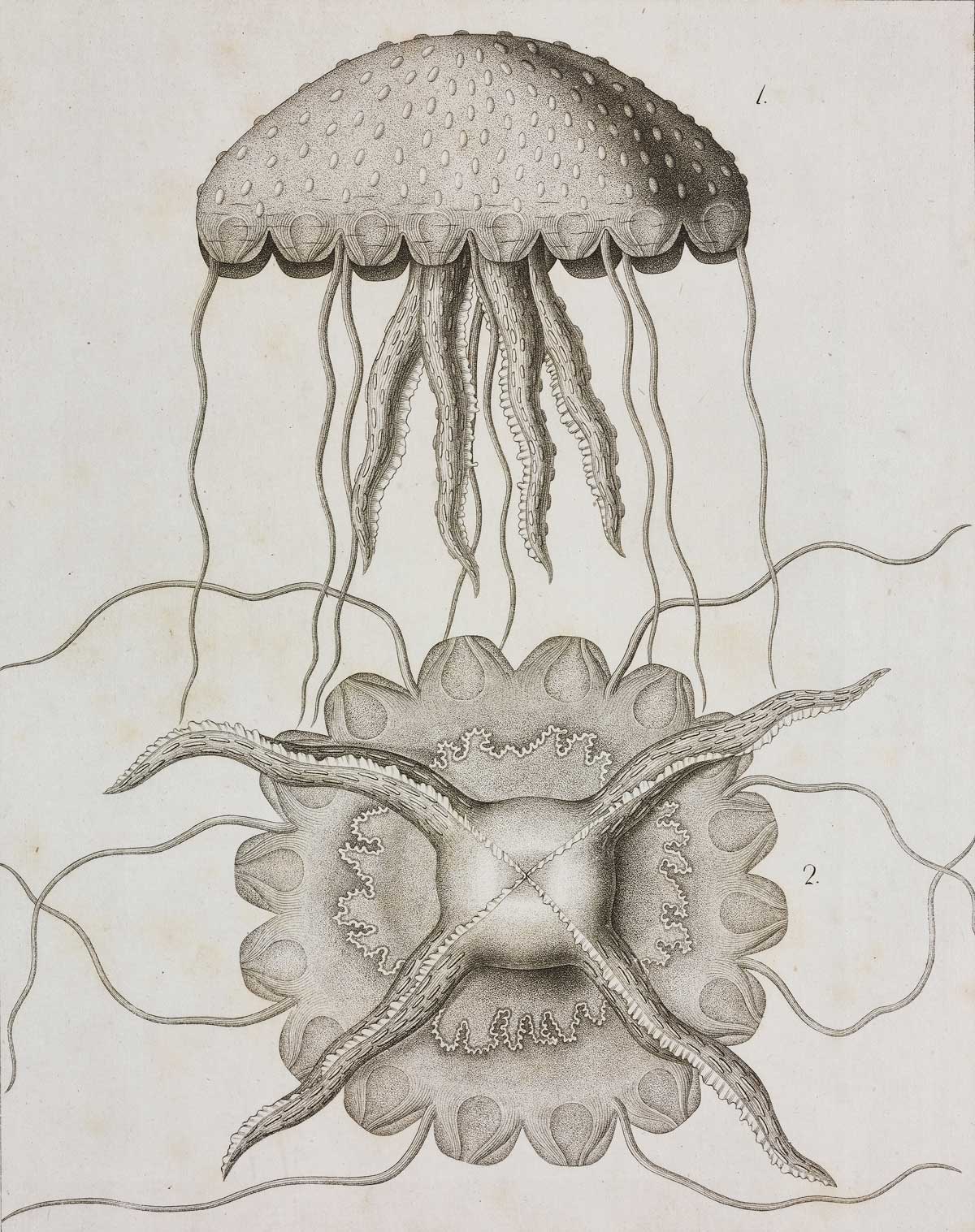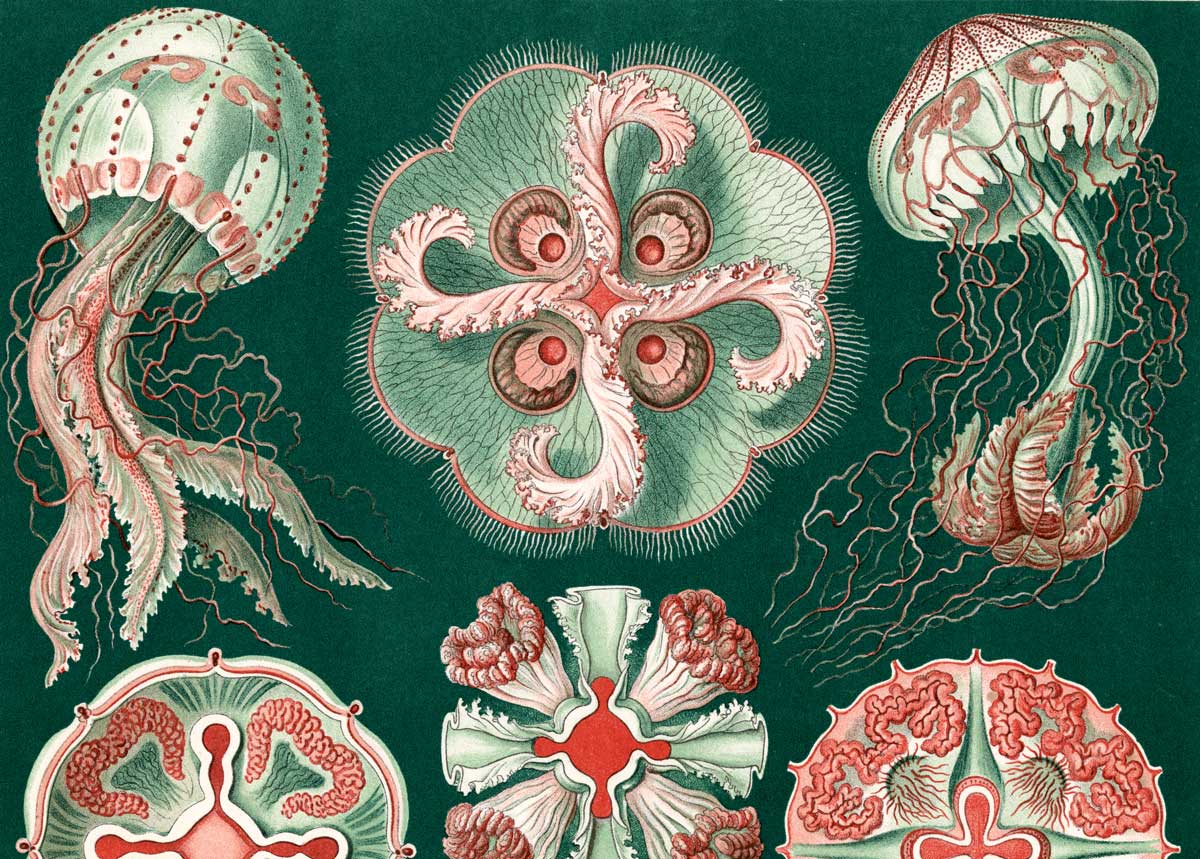The Jellyfish Problem
Plant, animal or other? The struggle to categorise jellyfish mirrors the desire to impose a hierarchy on the natural world.

After turning 30, Ernst Haeckel (1834-1919) couldn’t look at a jellyfish without seeing his fiancée’s face. He had first become fascinated with medusae ten years before, while on a fishing trip in Heligoland. Hauling them into his boat, he had been captivated by their strange, gelatinous ‘beauty’. They did not, to be sure, put him in mind of anyone at first; but when, a decade later, his fiancée, Anna Sethe, unexpectedly died on his 30th birthday, he sought solace in the strange creatures he dragged up from the deep. Indeed, so completely did he project his passion for Anna onto jellyfish that, when he named a new species after her (Mitrocoma annae) a few years later, his description read more like a love letter than a scientific text.
What drew Haeckel to jellyfish was, of course, not their physical resemblance to Anna, but their apparently inscrutable nature. Almost everything about them seemed to defy explanation. Although some varieties could grow to an enormous size, they were astonishingly simple. They had no true eyes, no central nervous system, no heart, no lungs, no blood – almost nothing, in fact, except a glutinous umbrella-shaped bell and a few tentacles dangling below. While the adult medusae were free-floating, the polyps from which they grew were fixed to the sea bed, like a hairy stalk. And, though jellies could sting, nothing but the most basic stimuli elicited any response. They were so simple, in fact, that it was difficult to say whether they were extremely rudimentary animals – or just very advanced plants..
‘Incomplete’
By the time of Anna’s death, biologists had already been puzzling over jellyfish for well over 2,000 years. Among the earliest was Aristotle. With his characteristic love of order, he had divided all forms of life into three categories, based on their vital functions. At the bottom of the scala naturae (‘ladder of nature’) were plants, which possessed only the nutritive and reproductive faculties. Above them came animals, which had perception as well. And at the very top, he placed humans, who had reason. It all seemed pretty straightforward. But there was a hitch. Although most creatures could be slotted into one category or another without much difficulty, there were a few which didn’t seem to fit. Of these, jellyfish were the most troublesome. Given that they lacked perception, they clearly weren’t animals. But since they weren’t attached to anything, they weren’t plants, either.
The problem wasn’t jellyfish themselves; it was Aristotle’s schema. However intuitive it might have seemed, its categories were simply too narrowly defined. As even Aristotle seems to have recognised, animals and plants were distinguished by more than just perception. Life just wasn’t that simple. But he still refused to give up on his system. Flawed though it may have been, it still worked for most forms of life. And since his goal was merely to identify different genera, he saw no need to change it just for the sake of a few outliers. He therefore dismissed jellyfish as ‘incomplete’ anomalies.
Not so black and white
Aristotle’s idea of a scala naturae proved hugely influential. Taken up by later classical writers, such as Theophrastus and Pliny the Elder, it came to dominate Christian thought – in part because of its close affinity with biblical accounts of the Creation. The basic division between plants, animals and humans was accepted without question; and the notion that some creatures were ‘higher’ (i.e. closer to God) than others was regarded as a truism.
Aristotle’s distinction between animals and plants was less warmly received, however. Recognising the limitations of relying on perception alone, natural philosophers gradually enlarged the definition of an animal to include a wider range of physiological and behavioural characteristics – none of which was sufficient or necessary on its own. Thomas Aquinas (1225-74), for example, argued that the most obvious difference was the capacity to move voluntarily from one place to another. Since nothing could will itself to move without some sense of where it wanted to go, however, knowledge was also important. And since knowledge often required memory and hearing, these, too, could play a role.

Within this basic structure, animals and plants could be sorted into a hierarchy. This was done using a system of logical division based on preconceived dichotomies. Starting at the top, you simply worked downwards, asking simple either/or questions as you went. Was a creature warm or cold blooded Did it have feathers? Was its beak curved or straight?
The advantage of this was, of course, its flexibility. Whereas Aristotle had viewed life in black and white, it now became possible to accommodate shades of grey. But it nevertheless raised a troubling question: at what point did something stop being a plant and start being an animal? If animals could be distinguished by a range of different characteristics, how many did a creature need to qualify? And which were most important?
This left the jellyfish in an awkward position. Everyone agreed that they met some of the criteria needed to be an animal. They could move; and, though they appeared not to have any senses, they had at least some instincts. But it was not enough. And since their most obvious features (trailing tentacles, jelly-like hood) were sui generis, it was difficult to see how they were related to anything else using logical division alone. For Conrad Gessner (1516-65), it seemed easier just to stick with Aristotle’s view that they were ‘incomplete’. Dubbing them urtica soluta rondeletius (round, unattached nettles), Gessner simply bundled them together with a few other roundish, squishy, stinging things and left it at that.
Under the microscope
The invention of the microscope changed everything. Perfected by Antoine van Leeuwenhoek (1632-1723), this not only made it possible to examine the structure of living beings more closely than ever before, but also revealed the existence of an abundance of new micro-organisms, none of which could easily be categorised. This laid bare the inadequacies of the Aristotelian system. Whereas there had previously been only a handful of ‘incomplete’ exceptions to contend with, there were now tens – if not hundreds – of thousands.
If naturalists were to stand any chance of making sense of them, it was obvious that a new approach would be needed. The botanist John Ray (1627-1705) suggested a way forward. Rejecting logical division out of hand, he argued that living beings should be classified into ‘species’ on the basis of observed similarities alone. Decades later, Carl Linnaeus (1707-78) developed this further. In Systema naturae (1735), he outlined a system of classification consisting of five main levels: kingdom, class, order, genus and species. This allowed living beings to be organised more ‘naturally’ – and permitted a whole range of ‘anomalous’ creatures to be given a clear designation for the first time.

There was a catch, though. While Linnaeus’ method was a vast improvement on Aristotle’s, his underlying assumptions remained much the same. Each of the kingdoms was defined in a similarly simplistic manner and the boundary between them was still rather hazy. And since the division of higher taxa into lower units still proceeded from the top downwards, the result was just a more sophisticated version of the same old picture.
For jellyfish, the good news was that, unlike Aristotle and his heirs, Linnaeus classified them as animals. The bad news, however, was that his reasoning was every bit as arbitrary as Gessner’s. He had no clear idea of how they related to other creatures. Dumping them haphazardly in the class of vermes (‘worms’), he ascribed them to the ill-defined genus zoophyla (‘plant-like animals’) alongside sea cucumbers, starfish and plankton – at the very bottom of the natural order.
Up!
Thankfully, it did not take naturalists long to realise that, if classification was to be guided by observation, it was madness to work from the top down. Far better to start at the bottom, sort species into similar groups and work upwards, fleshing out definitions as they went.
Aided by advances in scientific technology and comparative anatomy, rapid progress was soon made. By the mid-19th century so much was known about different creatures that the previously crude understanding of animal and plant life had been abandoned and replaced with increasingly elaborate definitions. The only problem was that, the more naturalists discovered, the more difficult they found it to pin the difference down. There seemed to be an exception to everything. And because most naturalists insisted that animals had always existed in their current form, they often had difficulty grasping how apparently different species might still be related.
In the hope of solving this, some naturalists proposed a new grouping. Dubbed ‘protozoa’ or ‘protoctista’, it would consist of all those ‘indeterminate’ or ‘incomplete’ subjects, that seemed to bear no relation to anything else. But no one could agree whether it should be a class, a phylum, or a kingdom – much less what it should contain.
This left jellyfish in limbo. There were, of course, some who still believed that they were animals. In 1843, Richard Owen (1804-92) gave an exceptionally detailed description of their anatomy and argued forcefully for their inclusion in Animalia. But he struggled to explain why. He had to admit that, at certain stages in their life cycle, they actually looked more like protozoa – and when pushed, had to fall back on the ‘essentialist’ arguments of old.
Origins
It was Haeckel who came to the jellyfish’s rescue. At the beginning of the 19th century, naturalists had begun to realise that life was not as static and unchanging as it had once appeared. In Philosophie Zoologique (1809), Jean-Baptiste Lamarck (1744-1829) argued that all creatures underwent a constant process of ‘transmutation’ over time. A few years later, Robert Chambers (1802-81) observed that, if this were true, all forms of life currently in existence must have developed out of earlier forms – and produced a rudimentary diagram showing how birds, fish and reptiles might have emerged as ‘offshoots’ of mammalian development.
Yet not until Charles Darwin were the full implications of this idea understood. In On the Origin of Species (1859), Darwin argued that the diversity of life was the result of a gradual process of evolution by natural selection. All life could ultimately be traced back to a single common ancestor and the diversity of life forms could be represented better by constructing a kind of ‘family tree’ than by arranging different species into a hierarchy of perfection.
Having struck up a correspondence with Darwin before Anna’s death, Haeckel set himself to the task of drawing up just such a ‘tree of life’. His most successful effort appeared in his Generelle Morphologie der Organismen (1866). This clearly illustrated the evolution of organisms through time from the simplest to the most complex – and succeeded in laying the ‘jellyfish problem’ to rest, once and for all. Haeckel showed that they were unequivocally animals. Extremely primitive animals, to be sure – but animals, none the less. And the reason they were so unlike any others was that they had split off from the rest at an earlier date.
Since then, of course, Haeckel’s phylogenetic tree has been revised many times; but jellyfish are still there, basking in the glory of being animals, and grateful, no doubt, for one man’s love – and loss.
Alexander Lee is a fellow in the Centre for the Study of the Renaissance at the University of Warwick. His latest book is Machiavelli: His Life and Times (Picador, 2020).